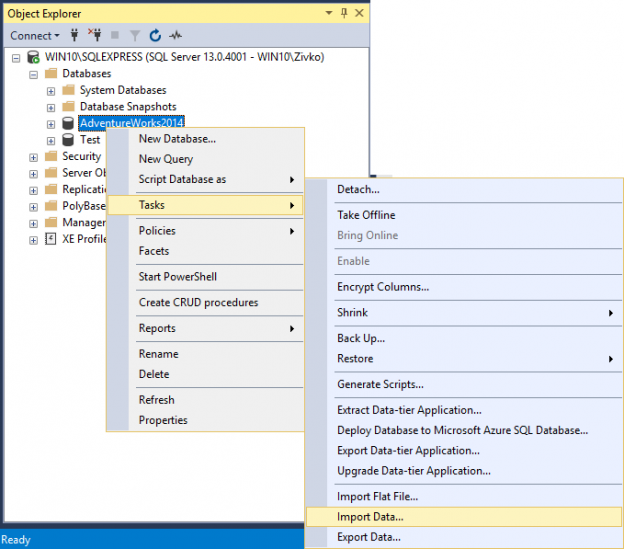

- #Mysql insert sql file into database how to#
- #Mysql insert sql file into database update#
- #Mysql insert sql file into database code#
The " id" field is AUTO_INCREMENT, so it's no need to be specified in the SQL query becouse MySQL will automatically adds the value for it. This example uses the "users" table created in the previous lesson, with five columns ( id, name, pass, email and reg_date). The following example adds one new record to the "users" table. To get PHP to execute the SQL statements, you must use the mysqli query() method. If a column is AUTO_INCREMENT or TIMESTAMP, it's no need to be specified in the SQL query becouse MySQL will automatically sets and adds the value. When you use the LOCAL option in the LOAD DATA INFILE, the client program reads the file on the client and sends it to the MySQL server. Note that if a column cannot have a NULL value (it was defined as NOT NULL) and does not have a default value, not specifying a value will cause an error. Importing file from client to a remote MySQL database server It is possible to import data from client (local computer) to a remote MySQL database server using the LOAD DATA INFILE statement. Any columns not given a value will be treated as NULL (or given a default value, if one was defined). Syntax: INSERT INTO table_name (column1, column2, column3.)VALUES (value1, value2, value3.)This method is generally preferable, you can add data only in the columns that matter. If there are five columns in the table, you must list five values.Ģ) The second form specifies both the column names and the values to be inserted: )In this method, you must specify a value, even if it's NULL, for every column. Syntax: INSERT INTO table_nameVALUES (value1, value2, value3. There are two ways that an INSERT query can be written:ġ) The first method doesn't specify the column names where the data will be inserted, only their values. Insert data into a MySQL tableTo add new records to a MySQL table, use the INSERT INTO statement.
#Mysql insert sql file into database update#
UPDATE seeme SET filecontents LOADFILE('/var/lib/mysql-files/myfile.txt') If you want to extract the file content into the new file you could use SELECT. Code: mysql> LOAD DATA LOCAL INFILE '/path/to/file.txt' INTO TABLE your-table-name sysgate. INSERT INTO seeme (filecontents) VALUES (LOADFILE('/var/lib/mysql-files/myfile.txt')) or in an update query. Here’s an example of what a query might look like when inserting the contents of the file into a database: INSERT INTO MyTable (FileId, UserId, MyBlobColumn) VALUES (1, 20, LOADFILE ('/data/test.txt')) In this case, the column MyBlobColumn has a data type of BLOB (which allows it to store binary data).

In fact, it works successfully when I don't open SSMS as an admin on the server instance and on the instance on my home computer. I moved it to the C:\ on the server and the select/insert worked. However, to display the file, all we need is the file name. You know, to store a file into a database table, the table must have a column whose data type is BLOB (Binary Large OBject). LOAD DATA local INFILE 'mytable1-tmp.txt' INTO TABLE mytable1 This should reduce the number of queries to one per table rather than one per row.
#Mysql insert sql file into database how to#
We also place a description of the file in the database. In this JDBC tutorial, you will learn how to insert binary data (or file data) into database. Then for each temporary file construct a query to insert the data from that file to your db. In the MySQL database, all you do is place the file name. All i need done is to get those values from the HTML table into a mysql database. After the all the formulas has run, then it populates the table as attached.
#Mysql insert sql file into database code#
I created a files folder (or directory) on my website which the files will upload to. I am not going to add all the code as there is a tonne, but this is the just of it. We put the files in a regular folder on our website.

I guess my login (or whatever SSMS uses) didn't have permissions to read the file on my desktop. In order to insert files into a MySQL database, as explained before, we don't actually put the files in the database. After a database and its table(s) have been created, you can start adding data in them. The problem was with the file location on the desktop.


 0 kommentar(er)
0 kommentar(er)
